
Adams National Historical Park, formerly Adams National Historic Site, in Quincy, Massachusetts, preserves the home of United States presidents John Adams and John Quincy Adams, of U.S. envoy to Great Britain, Charles Francis Adams, and of writers and historians Henry Adams and Brooks Adams.

The John Adams Birthplace is a historic house at 133 Franklin Street in Quincy, Massachusetts. It is the saltbox home in which Founding Father and second president of the United States, John Adams, was born in 1735. The house was designated a National Historic Landmark in 1960, and is listed on the National Register of Historic Places. It is now administered by the National Park Service as part of the Adams National Historical Park, and is open for guided tours.

The John Quincy Adams Birthplace is a historic house at 141 Franklin Street in Quincy, Massachusetts. It is the saltbox home in which the sixth United States President, John Quincy Adams, was born in 1767. The family lived in this home during the time John Adams helped found the United States with his work on the Declaration of Independence and the American Revolutionary War. His own birthplace is only 75 feet (23 m) away, on the same property.

The Josiah Quincy House, located at 20 Muirhead Street in the Wollaston neighborhood of Quincy, Massachusetts, was the country home of Revolutionary War soldier Colonel Josiah Quincy I, the first in a line of six men named Josiah Quincy that included three Boston mayors and a president of Harvard University.

Tudor Place is a Federal-style mansion in Washington, D.C. that was originally the home of Thomas Peter and his wife, Martha Parke Custis Peter, a granddaughter of Martha Washington. The property, comprising one city block on the crest of Georgetown Heights, had an excellent view of the Potomac River.

The Massachusetts Historical Society (MHS) is a major historical archive specializing in early American, Massachusetts, and New England history. The Massachusetts Historical Society was established in 1791 and is located at 1154 Boylston Street in Boston, Massachusetts, and is the oldest historical society in the United States.

The Dorothy Quincy Homestead is a US National Historic Landmark at 34 Butler Road in Quincy, Massachusetts. The house was originally built by Edmund Quincy II in 1686 who had an extensive property upon which there were multiple buildings. Today, the site consists of the Dorothy Quincy Homestead, which has been preserved as a museum and is open occasionally to the public.
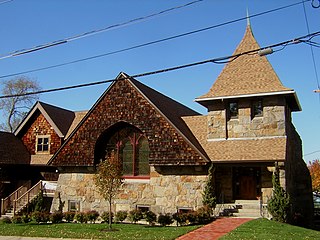
The Wollaston Unitarian Church, more recently a former home of the St. Catherine's Greek Orthodox Church, is a historic church building at 155 Beale Street in Quincy, Massachusetts. Built in 1888 to a design by Edwin J. Lewis Jr., it is a prominent local example of Shingle Style architecture. It was added to the National Register of Historic Places in 1989. The building has been converted to residential use.

The Quincy Historical Society (QHS) is located at 8 Adams Street in Quincy, Norfolk County, Massachusetts, United States. It was founded in 1893 by Charles Francis Adams, Jr. Dr. Edward Fitzgerald is the executive director.

The Charles E. White House is a historic house at 101 Billings Road in Quincy, Massachusetts. This 2+1⁄2-story wood-frame house was built c. 1905 by Charles White, a traveling salesman. It is a well-preserved local example of late Shingle styling, with a cross-gable roof configuration and a side-hall entry plan. It has a number of projecting bay windows, and a gable window set in a curved recess. Its original shingling has been either covered or replaced by modern siding.

Quincy Water Company Pumping Station was a historic pumping station at 106 Penn Street in Quincy, Massachusetts. The two-story brick Italianate building was built in 1883 to meet the demand of Quincy's growing population for water. In addition to the pumping facilities, the building house offices and an apartment for the superintendent. Its use as a pumping station was discontinued in 1899 after Quincy joined with what is now called the MWRA.
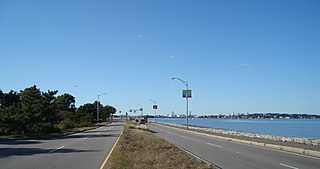
Quincy Shore Drive is a historic parkway in Quincy, Massachusetts. The road is one of a series of parkways built by predecessors of the Massachusetts Department of Conservation and Recreation, to provide access to parks and beaches in the Greater Boston area. Its development was proposed in 1893 by Charles Eliot, who promoted the development of many of the area's parks and parkways. Planning began in 1897, with land acquisition following around 1900. Construction of the 4-mile (6.4 km) road was begun in 1903 and completed in 1907.

The Solomon Nightengale House was a historic house at 429 Granite Street in Quincy, Massachusetts. The 1+1⁄2-story Cape style house was built c. 1820 by Solomon Nightengale, whose family had owned the land since the 18th century. It had a four-bay facade, with a central chimney and a sheltered entry in the center-left bay. The house was listed on the National Register of Historic Places in 1989.

The Edwin W. Marsh House is a historic house at 17 Marsh Street in Quincy, Massachusetts. The 1+1⁄2-story five-bay wood-frame house was built c. 1851, and had a rear ell. The Cape style cottage had vernacular Greek Revival styling, including corner pilasters. It had a bracketed entry portico that was probably added during the Italianate period (1860s-70s).

S. H. Barnicoat Monuments, S. H. Barnicoat Granite Works, or, more recently, Hancock Monument Co. was a granite workshop at 114 Columbia Street, at the corner of Centre Street, in Quincy, Massachusetts. It was housed in a rare surviving 19th-century granite workshop building dating to the 1890s, and was, at the time of its listing on the National Register of Historic Places in 1989, one of the only 19th-century granite workshops operating in the city. Its main feature was a derrick more than 90 feet (27 m) tall that was used to move granite around the property.

The Brown–Hodgkinson House is a historic house at 42 Bicknell Street in Quincy, Massachusetts. This two story wood-frame house, built in 1832, was one of the first in what is known as the Germantown neighborhood. It was built by Captain Charles Brown, who moved here from Provincetown, seeing the beginning of growth of a fishing community. The house is predominantly Federal in character, and received Queen Anne detailing in the 1880s.
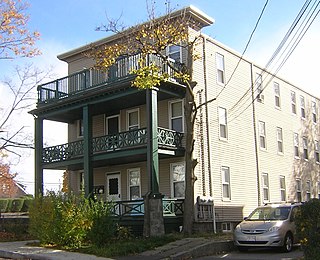
The Building at 51 Hunt Street in Quincy, Massachusetts, is one of a relatively small number of triple decker apartment buildings in the city. Built in 1907 by Charles Stratton as part of his development of North Quincy as a rail-commuter suburb, it is a three-story wood-frame structure, with a flat roof and wooden clapboard siding. The building is notable for its high parapet and its unusual porch balustrades. The roof line has a cornice with dentil moulding and simple brackets.
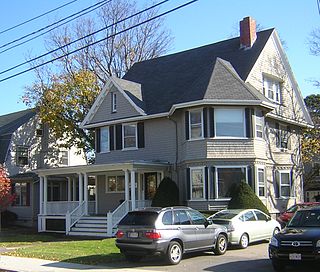
The Charles H. Burgess House is a historic house at 17 Whitney Road in Quincy, Massachusetts. The 2+1⁄2-story wood-frame house was built c. 1903 by Charles H. Burgess, a real estate developer and auction-house owner. The house exhibits both Queen Anne and Shingle styling, with Queen Anne-like projecting corner bay, and a wraparound porch supported by paired columns. Decorative cut shingles make a string course under a slight flare at the base of the second floor.
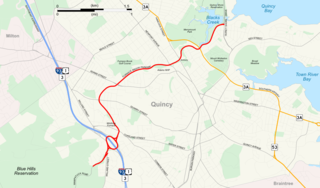
Furnace Brook Parkway is a historic parkway in Quincy, Massachusetts. Part of the Metropolitan Park System of Greater Boston, it serves as a connector between the Blue Hills Reservation and Quincy Shore Reservation at Quincy Bay. First conceived in the late nineteenth century, the state parkway is owned and maintained by the Massachusetts Department of Conservation and Recreation (DCR) and travels through land formerly owned by the families of John Adams and John Quincy Adams, passing several historic sites. It ends in the Merrymount neighborhood, where Quincy was first settled by Europeans in 1625 by Captain Richard Wollaston. The road was started in 1904, completed in 1916 and added to the National Register of Historic Places (NRHP) in 2004.





















